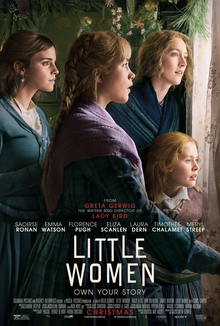
It has been almost exactly a year since we watched the well loved 1994 adaptation so it’s still quite fresh in our minds. We were always going to watch this new version due to its stellar cast and the fact it is directed by Greta Gerwig. Unfortunately while this completely blows away the older film in terms of production values and visual beauty, it also makes some unconventional decisions with regards to presenting the sequence of events and emphasizing different aspects of their lives. This serves to differentiate the new version but I’m not sure that it’s for the better.
The film flits between 1868 when the family of four daughters have each gone their separate ways and seven years earlier when they first befriend their neighbor Laurie. In 1868, Jo March lives in a boarding house in New York, trying to get her stories published and has befriended Friedrich Bhaer, a professor from Germany. The eldest sister Meg has married John, Laurie’s tutor and the youngest sister Amy is in Paris with their Aunt March, working on her painting skills and hoping to snag a wealthy husband. The middle sister Beth has gotten sick again and so Jo hurries back home. Meanwhile the scenes set earlier set the stage for all these events: how their mother takes care of the four of them while their father is fighting in the Civil War and encourages them to be kind; how they befriend Laurie and his grandfather; and how Beth first got sick from taking care of a poor immigrant family. Though relatively poor, they are happy and have well-meaning friends but the girls must soon think of their marriages and that means getting married.
The unusual structure that the director chooses to employ here means that we are shown what happens to the girls later in life before we see them growing up in their household and how they include Laurie as part of their play group. The confusion of continually having to switch between past and present means that it will be very difficult for anyone who isn’t already familiar with this story to follow along with what happens. I believe that Gerwig is working on the assumption that audiences do already know the story and so chooses to move scenes around to differentiate this adaptation from older ones and to emphasize different aspects. In particular, the role of Friedrich is greatly diminished here as the audience doesn’t get to know him at all and there is even an implication on a meta level that Jo’s happy ending with him may not be real and was just an addition that was needed to help sell the story. There are places where this works well. Beth’s illness in particular feels like one long extended episode with both her past and present bouts of scarlet fever interspersed together and heightens the sense of tragedy. But overall I found it much harder to properly empathize with the characters due to this structure.
The upside is that this film is unquestionably beautiful with some truly striking shots and a wonderful level of attention to period detail. A great example of this is the scene of them visiting the beach. I mean, sure we know how beach days go but I bet you probably haven’t seen one that takes place in 1868. This pattern holds for much of the film. Scenes, individually considered, are well made and very effective. But I feel that the unusual sequence that the scenes are put into detracts from properly getting to know the characters and weakens the dramatic impact of pivotal events. Meg’s relationship with John for example induces emotional whiplash due to the non-chronological order in which we perceive their developing romance. Perhaps the director intended to make a subtler point with this presentation but I feel that a more conventional sequence would have been more effective. In the middle of all this jumping around in time, it even feels like there are scenes missing as if we were being expected to fill in blanks due to our prior knowledge of a familiar story.
As a result this is a beautiful film that I would like to like, but don’t really do. The older 1994 adaptation is far more traditional but it still feels like the superior film to me and I do not think that this is the kind of source material that benefits from this kind of experimental approach.